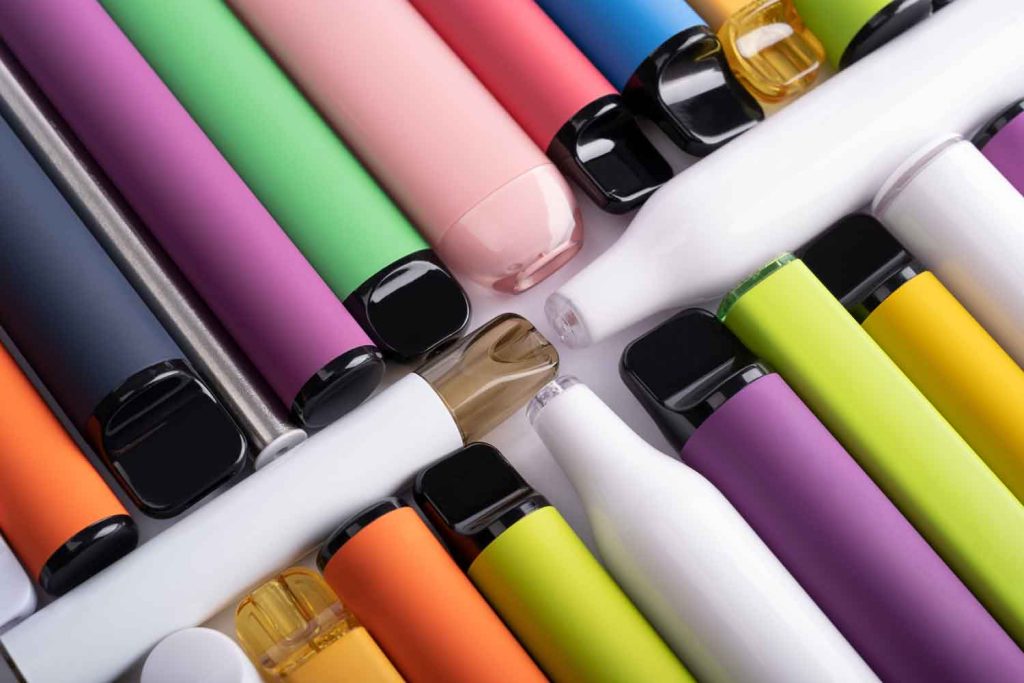A ‘Greenprint’ for Change
- Also in TR Print Edition Sustainability
- June 1, 2023
- 0
- 10 minutes read


The environmental challenges presented by disposable vapes can be addressed without banning the category.
By Stefanie Rossel
Over the past few years, sales of disposable vapes have skyrocketed in many markets. Future Market Insights valued the global disposable e-cigarette market at $6.34 billion in 2022 and expects demand to increase at a compound annual growth rate of 11.2 percent between 2022 and 2032, reaching $18.32 billion by 2032. In both the U.K. and Germany, the world’s No. 2 and No. 3 vape markets, respectively, the disposable segment now dominates the market with a share of more than 60 percent.
Disposable e-cigarettes are particularly popular among new users as these products come ready to use. There’s no need to fill up, press buttons or recharge. The single-use products, which can deliver up to 600 puffs—the equivalent of approximately three packs of cigarettes—don’t require any technical knowledge and are activated by drawing on them. They can be purchased almost anywhere where cigarettes are sold, which makes them attractive as an impulse buy. Nicotine salts offer a smooth vaping experience without a harsh throat hit, and sweeteners can be added without worrying about long-term contamination of the device as it is intended for short-term use anyway.
While disposables play a significant role in weaning smokers off combustible cigarettes, they are also increasingly attracting criticism. There are concerns not only about youth uptake but also about their environmental impact. Several countries, including France, Scotland and Belgium, are considering banning disposable vapes for this reason. In early May, Australia announced the prohibition of single-use e-cigarettes.
Like refillable devices, disposable vapes consist of a hard plastic shell, a metal heating element, a circuit board and a lithium-ion battery cell. They contain heavy metals and chemicals as well as nicotine-containing pods. In contrast to multiuse products, they are discarded after the last puff, thus posing a significant environmental burden. Some manufacturers and retailers offer takeback and recycling programs, but many vapers are unaware of the schemes. In addition, most users are oblivious to the fact that the products are electronic waste that need to be disposed of at recycling centers or returned to retailers; they simply throw the devices into the household trash.
Due to their construction, dismantling vapes is a difficult, costly, time-consuming process that involves a lot of manual work. As a result, instead of being recycled, many disposable vapes are incinerated, which is a waste of valuable raw materials. According to a Financial Times calculation conservatively assuming a $5 billion vape market in 2022, the more than 90 million tons of lithium used to manufacture e-cigarettes that year was enough to supply more than 11,000 electric vehicle batteries while the 1,160 tons of copper contained in the devices would suffice to produce more than 16 million home electric vehicle chargers.

Without proper regulation, there are obvious dangers that those who see vaping as their only way out of smoking will be forced to either switch back to cigarettes or risk buying products on the black market.
Backdoor Prohibition
While sharing the environmental concerns raised by critics, industry leaders believe there are better ways to address the problem than through bans. “We have seen in other countries that banning products will lead to smokers who were giving up [cigarettes], or planning to, returning to smoking,” says John Dunne, director general of the U.K. Vaping Industry Association (UKVIA). “There is also the risk that you just feed a black market in vaping products; you just have to look to the Australian model, where all vapes are banned except on prescription, which has led to a huge black market problem. Without proper regulation, there are obvious dangers that those who see vaping as their only way out of smoking will be forced to either switch back to cigarettes or risk buying products on the black market—with all the inherent risks involved in an unregulated market.”
Without spelling it out, EU regulators are preparing for a ban nonetheless. In December, the European Parliament and the council reached a provisional agreement to overhaul EU rules on batteries. The Battery Regulation, set to be passed this year, stipulates that 3.5 years after the rule comes into force, the batteries in portable devices must be removable and replaceable by the user. For disposable vapes, the new rules mean a de facto ban from the end of 2026.
Dustin Dahlmann, president of the Independent European Vape Alliance, observes that an increasing number of single-use e-cigarettes is already switching to reusable systems. “This doesn’t happen merely for environmental reasons but also because of cost. We are convinced that this trend will continue. Manufacturers of disposable vapes increasingly launch their products as reusable versions. This is welcomed by consumers, not least because it makes vaping more affordable.”
All retailers, he adds, are obliged to point out the correct disposal of one-way products to consumers. “Our campaigns in the past received positive feedback, and we are convinced that they have had a noteworthy effect. It’s also clear, however, that education of consumers must be continued at all levels.”

Manufacturers of disposable vapes increasingly launch their products as reusable versions.
There’s a Better Way
In the U.K., a similar review of battery legislation has been delayed twice. The country has successfully embraced vaping as a tool for reducing smoking, but even as many smokers have quit with the help of e-cigarettes, the country has recently witnessed a surge in youth uptake, which in turn has sparked discussion about banning disposables. Such a move, Dunne says, would limit the positive impact of vaping on smoking rates, “and more smokers means more deaths and more cost to society.”
Instead of talking about bans, vaping advocates say regulators should focus on reducing the negative effects of disposable vapes. “On youth access, the UKVIA has been calling on government to police the sale of vapes to under-18s more effectively through a number of simple steps, including on-the-spot fines for rogue resellers of up to £10,000 ($12,660), up from £2,500,” he says. “On environmental impact, the UKVIA recently held a webinar which brought together politicians, regulators, manufacturers and the waste industry to discuss the issue and subsequently published a 22-point action plan for all stakeholders to help meet the challenge. More needs to be done in both areas, and we remain committed to working with all stakeholders to build effective solutions.”
Dubbed “Greenprint for Sustainable Vaping,” the plan proposes that retail staff receive enhanced training so that they can properly inform customers about recycling options and the greater cost-effectiveness of multiuse devices. Under the plan, shop operators would also be advised to place prominently located collection points in their stores and encourage vapers to use them.
Manufacturers and retailers should offer incentives to customers for recycling used devices and develop public information campaigns to normalize recycling so that vapers feel peer pressure to recycle and social shame if they don’t.
The plan calls for packaging to reinforce the message that vape devices must be recycled and for vape manufacturers to be acquainted with waste processing so that they can design their products in a way that will facilitate recycling. According to the action plan, all relevant vape businesses should be compliant with the Waste Electrical and Electronic Equipment Regulations 2013, the Producer Responsibility Obligations (Packaging Waste) Regulations 2007 and other rules.
Most vape manufacturers are innovating to make their products more environmentally friendly, says Dunne. “For example, one brand I know of is going to be launching a single-use device later this year which is over 50 percent cardboard and uses biodegradable silicon in place of plastic. Another challenge for the waste companies is actually dismantling devices, and this is also an area where manufacturers are working hard to make the process easier. We’re not there yet, but there is lots of focus on this issue, and I am optimistic that the various stakeholders can work together to find workable solutions.”
Dunne says there is a simpler way of preventing youths from buying disposable vapes and at the same time limiting the waste problem than introducing taxes on single-use e-cigarettes, as has also been debated. “It is smokers from a disadvantaged background—who are generally in the highest smoking rate areas—who will be hit hardest by a tax on vapes, and for every one of them who returns to smoking as a result, that is a step back for all of us,” he says.
“There is a much better solution staring us in the face. There is currently a maximum fill level of 2 mg of e-liquid in a vape, single-use or otherwise, and this arbitrary number has no logic to it, safety or otherwise. If the government were to introduce a minimum fill level of 10 mg, you instantly achieve a number of things; firstly, the price would rise to around £15 or more, pricing out underage users, and you would reduce the environmental impact by 80 percent overnight.”

